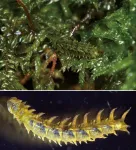How hypertension leads to atherosclerosis research scientists at
Research scientists at Aarhus University and Aarhus University Hospital have investigated the mechanisms by which hypertension leads to arterial damage and atherosclerosis; the results may facilitate the development of new therapies
2021-02-25
(Press-News.org) Research scientists at Aarhus University and Aarhus University Hospital have investigated the mechanisms by which hypertension leads to arterial damage and atherosclerosis. The results may facilitate the development of new therapies.
Hypertension is a prevalent condition affecting approximately one third of all adults. It is also the leading global cause of morbidity and mortality. The condition is often asymptomatic, but over time it may damage arteries causing atherosclerosis and possibly leading to stroke and heart attack.
Despite the prevalence of the disease and its potentially severe consequences, how hypertension leads to atherosclerosis has been poorly understood. In a study from Aarhus University and Aarhus University Hospital, an international team of researchers have identified several steps in this proces. The study was conducted in pigs, due to the similarities between the cardiovascular systems of pigs and humans.
"One of our primary findings is that hypertension is able to exert its detrimental effect on the artery wall through direct mechanical pressure, without the involvement of hormones carried around the bloodstream", says the lead author behind the study, Rozh Al-Mashhadi, associate professor and radiologist at AU and AUH.
He adds that the question of whether the arterial damage is caused by high pressure per se or via the involvement of hormones, has been the topic of discussion in the research community for decades.
Unveiling the mechanisms behind hypertension-induced atherosclerosis has important implications:
"We have several treatments for hypertension aiming at reducing blood pressure to normal levels. However, this may not be adequately maintained in all patients. In order to develop new therapies, we need to clarify the mechanisms by which hypertension damages the arterial wall," he explains.
Leads to increased accumulation of bad cholesterol
The researchers have also identified the fundamental step linking hypertension to atherosclerosis. The team demonstrated that hypertension leads to increased accumulation of a bad form of cholesterol - so-called LDL cholesterol - in the arterial wall. Rozh Al-Mashhadi explains that this type of cholesterol is pivotal for the development of atherosclerosis.
Finally, the researchers investigated how hypertension leads to increased accumulation of cholesterol in the artery wall:
"We used a technique that simultaneously quantifies all proteins in the artery wall. We found that hypertension caused structural changes in the arterial wall, reducing the transport of proteins from the blood into wall itself. Like in a sieve where the holes are too small, this may explain why we see increased cholesterol accumulation leading to atherosclerosis," says Rozh Al-Mashhadi.
The results were published in the Journal of the American College of Cardiology. The study may aid in developing new therapies for hypertensive individuals.
"The new findings may enable us to devise treatment strategies targeting the newly discovered disease mechanisms. Hypertension and atherosclerosis are major health concerns, so there is a lot at stake," says Rozh Al-Mashhadi.
INFORMATION:
About the study:
Type of study: Translational research
Collaborators: Professor Jacob Bentzon, Department of Clinical Medicine, Aarhus University; Professor Erling Falk, Department of Clinical Medicine, Aarhus University; Professor Jesús Vázquez, Spanish National Cardiovascular Research Center, Madrid, Spain.
Funding: Independent Research Fund Denmark, Danish Heart Foundation, Lundbeck Foundation.
Read the scientific paper here
Contact:
Research radiologist, Associate Professor, PhD Rozh H. Al-Mashhadi
Aarhus University, Department of Clinical Medicine
and Aarhus University Hospital, Department of Radiology.
rham@clin.au.dk
ELSE PRESS RELEASES FROM THIS DATE:
2021-02-25
Soil microorganisms play a critical role in the survival of life-sustaining ecosystems and, consequently, human well-being. Global assessments continue to provide strong evidence that humans are causing unprecedented biodiversity losses. However, existing information is strongly biased towards selected groups of vertebrates and plants, while much less is known about potential shifts in belowground communities.
Soil microbial communities are largely an unseen majority, even though, according to first author Dr Carlos Guerra (iDiv, MLU), "they control a wide range of ecosystem functions that have implications for both human well-being ...
2021-02-25
Job applications from men are disfavoured when they apply for work in female-dominated occupations. Reaching the interview stage was most difficult for men applying for jobs as cleaners. These are the results of a study by researchers from Linköping University and the University of California, Irvine, recently published in the scientific journal PLOS One.
"We see that there are obstructions to men entering certain parts of the labour market. In the application process, we don't see any discrimination against women who want to get into male-dominated occupations. ...
2021-02-25
Our deep-rooted survival instinct for disease avoidance could make us less willing to embrace strangers and take foreign travel risks.
"We wanted to look beyond the current crisis and consider the future psyche of the post-COVID-19 traveller," says Associate Professor Florian Kock of Marketing and Tourism at Copenhagen Business School.
The research is the first of its kind that goes beyond the surface and finds longer-term psychological consequences; discovering that the pandemic has affected tourists' attitudes and behaviours in unforeseen ways, often subconsciously.
The research found post-pandemic tourism could curb our ...
2021-02-25
A series of experiments at the ALTO particle accelerator facility in Orsay, France, has revealed that the fragments resulting from nuclear fission obtain their intrinsic angular momentum (or spin) after fission, not before, as is widely assumed. This result was made possible by the 'nu-ball' collaboration, an international group of nuclear physicists from 37 institutes and 16 countries - among them scientists from TU Darmstadt's Institute of Nuclear Physics - which studied a wide range of nuclei and their structure. The collaboration is led by the Irène-Joliot-Curie Laboratory in Orsay.
Open questions since the 1930s
Nuclear fission, in which a heavy nucleus splits in two and releases energy, was already discovered at the end of the 1930s by the chemists Otto Hahn and Fritz ...
2021-02-25
Eye conditions that do not cause vision impairment but have economic and social consequences represent a serious and growing challenge for public health services worldwide, according to a new paper published by The Lancet Global Health Commission.
According to research by the Vision Loss Expert Group, led by Professor Rupert Bourne of Anglia Ruskin University (ARU), issues such as glaucoma, sore eyes, conjunctivitis and diabetic retinopathy affected hundreds of millions of people across the world in 2020 without causing moderate or severe vision impairment, and an ageing population means instances of these conditions are growing. In the UK, conditions that do not cause sight loss or blindness account for around 88% of GP consultations related to eye health.
The ...
2021-02-25
Different physical structures play an important role in animal camouflage; however, they are rarely studied compared to the camouflage colors and patterns. All known larvae of long-bodied crane flies (Cylindrotominae) are plant-feeders, feeding either on mosses or herbaceous plants. The terrestrial moss-feeding larvae resemble mosses to a remarkable degree (Fig. 1). The larvae not only have cryptic coloration and patterning, but also are cloaked with special armature; cryptic, fleshy lobes surround their body on dorsal, lateral, and ventral sides. These complex traits serve to ...
2021-02-25
As COVID-19 sweeps the world, related viruses quietly circulate among wild animals. A new study shows how SARS-CoV-2, the virus that causes COVID-19, and SARS-CoV-1, which caused the 2003 SARS outbreak, are related to each other. The work, published recently in the journal Virus Evolution, helps scientists better understand the evolution of these viruses, how they acquired the ability to infect humans and which other viruses may be poised for human spillover.
"How did these viruses come to be what they are today? Why do some of them have the ability to infect humans while others do not?" said Simon Anthony, associate professor ...
2021-02-25
WASHINGTON--Hospitalized patients with COVID-19 and abnormal sodium levels in the blood have an increased risk of experiencing respiratory failure or dying, according to a study published in the Endocrine Society's Journal of Clinical Endocrinology & Metabolism.
"This study shows for the first time that patients presenting at the hospital with COVID-19 and low sodium are twice as likely to need intubation or other means of advanced breathing support as those with normal sodium," said lead investigator Ploutarchos Tzoulis, M.D., Ph.D., M.Sc., Honorary Associate Professor in Endocrinology at University College London (UCL) Medical School in London, U.K.
Additionally, the researchers found ...
2021-02-25
An improved high-tech fluorescence microscopy technique is allowing researchers to film cells inside the breast as never seen before.
This new protocol provides detailed instructions on how to capture hi-res movies of cell movement, division and cooperation, in hard-to-reach regions of breast tissue.
The technology - called multiphoton microscopy - uses infrared lasers to illuminate fluorescently labelled breast cells without harming them, so that elusive cell behaviours can be observed within living tissue.
With the new method, WEHI researchers have revealed how breast cells rearrange, interact and sense their environment as the breast grows during development and recedes after lactation.
Cell imaging within living tissue has been ...
2021-02-25
As the frequency and size of wildfires continues to increase worldwide, new research from Carnegie Mellon University scientists shows how the chemical aging of the particles emitted by these fires can lead to more extensive cloud formation and intense storm development in the atmosphere. The research was published online today in the journal Science Advances.
"The introduction of large amounts of ice-nucleating particles from these fires can cause substantial impacts on the microphysics of clouds, whether supercooled cloud droplets freeze or remain liquid, and the propensity of the clouds to precipitate," said Ryan Sullivan, associate ...
LAST 30 PRESS RELEASES:
[Press-News.org] How hypertension leads to atherosclerosis research scientists at
Research scientists at Aarhus University and Aarhus University Hospital have investigated the mechanisms by which hypertension leads to arterial damage and atherosclerosis; the results may facilitate the development of new therapies


